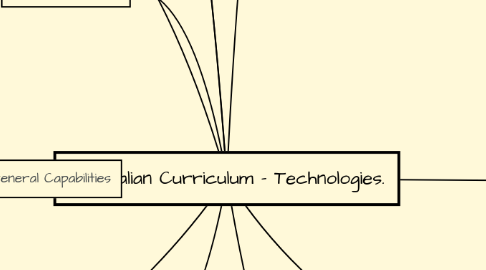
1. Key Ideas
1.1. Overarching idea: Creating preferred futures
1.1.1. Prepares students for future technologies and jobs
1.1.2. Develop skills to identify possible and probable features.
1.2. Project Management
1.3. Thinking in Technologies
1.3.1. System Thinking
1.3.2. Design Thinking
1.3.3. Computational Thinking
1.3.4. Safety
1.3.5. Animal Ethics
2. Student Diversity
2.1. Technology ensures all students can partake in the Australian curriculum. This includes students who speak English as a second language, students with disabilities and Indigenous students.
3. General Capabilities
3.1. Literacy
3.2. Numeracy
3.3. ICT
3.4. Critical and Creative Thinking
3.5. Personal and Social Capabilities
3.6. Ethical Understanding
3.7. Intercultural Understanding
3.8. Science
3.9. HASS
4. Band Level
4.1. F-2
4.2. 3-4
4.3. 5-6
4.4. 7-8
4.5. 9-10
5. Achievement Standards
5.1. The achievement standards outline what is expected in each year level, giving an indication of what needs to be taught and what students already know. This allows for progression of students knowledge to continue over the years they are at school.
6. Links to other Learning Areas
6.1. Health and Physical Education
6.2. Engligh
6.3. Maths
6.4. The ARTS
6.5. Science
6.6. HASS
7. Subject
7.1. Digital Technologies
7.2. Design and Technologies
8. Rationale
8.1. It is important to teach technology so students have opportunities to develop skills such as creating innovative solutions, independently and collaboratively, developing knowledge, understanding and gaining skills to respond creatively to current and future needs.
9. Aims
9.1. Aims to develop knowledge, understanding and skills.
9.2. Design and Technologies
9.2.1. Develop confidence to investigate, generate and create/produce using a range of technologies.
9.2.2. Use and design systems and evaluate the processes used.
9.3. Digital Technologies
9.3.1. Confidently and competently use digital technologies efficiently and effectively.
9.3.2. Apply protocols and legal practices that support safe, ethical and respectful communications
10. Cross Curricula Priorities
10.1. Aboriginal and Torres Strait Islander Histories and Cultures
10.2. ASIA and Australia's Engagement with Asia
10.3. Sustainability
11. Content Descriptors and Elabortations
11.1. Design and Technologies
11.1.1. Strands
11.1.1.1. Design and Technologies Processes and Production Skills
11.1.1.1.1. Explore needs or opportunities for designing, and the technologies needed to realise designed solutions (ACTDEP005)
11.1.1.1.2. Generate, develop, and communicate design ideas and decisions using appropriate technical terms and graphical representation techniques (ACTDEP015)
11.1.1.1.3. Select appropriate materials, components, tools, equipment and techniques and apply safe procedures to make designed solutions (ACTDEP026)
11.1.1.2. Design and Technologies Knowledge and Understanding
11.1.1.2.1. Explore how technologies use forces to create movement in products (ACTDEK002)
11.1.1.2.2. Investigate food and fibre production and food technologies used in modern and traditional societies (ACTDEK012)
11.1.1.2.3. Investigate characteristics and properties of a range of materials, systems, components, tools and equipment and evaluate the impact of their use (ACTDEK023)
11.1.1.2.4. Investigate characteristics and properties of a range of materials, systems, components, tools and equipment and evaluate the impact of their use (ACTDEK023)
11.2. Digital Technologies
11.2.1. Strands
11.2.1.1. Digital Technologies Knowledge and Understanding
11.2.1.1.1. Recognise and explore digital systems (hardware and software components) for a purpose (ACTDIK001)
11.2.1.1.2. Recognise different types of data and explore how the same data can be represented in different ways (ACTDIK008)
11.2.1.1.3. Examine the main components of common digital systems and how they may connect together to form networks to transmit data (ACTDIK014)
11.2.1.2. Digital Technologies Processes and Production Skills
11.2.1.2.1. Design a user interface for a digital system (ACTDIP018)
11.2.1.2.2. Implement simple digital solutions as visual programs with algorithms involving branching (decisions) and user input (ACTDIP011)
11.2.1.2.3. Follow, describe and represent a sequence of steps and decisions (algorithms) needed to solve simple problems (ACTDIP004)
